Example 1: Medical Terminology
The term "Salping-Oophorectomy" refers to
a. The removal of the fallopian tubes and ovaries
b. The surgical sampling or removal of a fertilized
egg
c. Cutting into the fallopian tubes and ovaries
for surgical purposes
d. Cutting into a fertilized egg for surgical purposes
Rational
Answer: A
The term "salp" means tube, the term "ooph"
refers to the ovary, and the suffix "ectomy" means to
surgically remove. Some CPT books (like the professional edition
put out by the AMA) contains pages with common medical terms like
these in the beginning of the book (prior to the coding guidelines)
Example 2: Musculoskeletal
OPERATIVE NOTE
PREOPERATIVE DIAGNOSIS: myelopathy secondary to
very large disc herniations at C4-C5 and C5-C6.
POSTOPERATIVE DIAGNOSIS: myelopathy secondary
to very large disc herniations at C4-C5 and C5-C6.
PROCEDURE PERFORMED:
1. Anterior discectomy, C5-C6
2. Arthrodesis, C5-C6
3. Partial corpectomy, C5
4. Machine bone allograft, C5-C6
5. Placement of anterior plate with a Zephyr C6
ANESTHESIA: General
ESTIMATED BLOOD LOSS: 60 mL
COMPLICATIONS: None
INDICATIONS: This is a patient who presents with
progressive weakness in the left upper extremity as well as imbalance.
He has a very large disc herniation that came behind the body at
C5 as well and as well as a large disc herniation at C5-C6. Risks
and benefits of the surgery including bleeding, infection, neurologic
deficit, nonunion, progressive spondylosis, and lack of improvement
were all discussed. He understood and wished to proceed.
DESCRIPTION OF PROCEDURE:
The patient was brought to the operating room and placed in the
supine position. Preoperative antibiotics were given. The patient
was placed in the supine position with all pressure points noted
and well padded. The patient was prepped and draped in standard
fashion. An incision was made approximately above the level of the
cricoid. Blunt dissection was used to expose the anterior portion
of the spine with carotid moved laterally and trachea and esophagus
moved medially. I then placed needle into the disc spaces and was
found to be at C5-C6. Distracting pins were placed in the body of
C6. The disc was then completely removed at C5-C6. There was very
significant compression of the cord. This was carefully removed
to avoid any type of pressure on the cord. This was very severe
and multiple free fragments noted. This was taken down to the level
of ligamentum. Both foramen were then also opened. Part of the body
of C5 was taken down to assure that all fragments were removed and
that there was no additional constriction. The nerve root was then
widely decompressed. Machine bone allograft was placed into C5-C6
and then a Zephyr plate was placed in the body C6 with a metal pin
placed into the body at C5. Excellent purchase was obtained. Fluoroscopy
showed good placement and meticulous hemostasis was obtained. Fascia
was closed with 3-0 Vicryl, subcuticular 3-0 Dermabond for skin.
The patient tolerated the procedure well and went to recovery in
good condition.
a. 22554, 63081, 63082, 20931, 22845
b. 22551, 63081, 20931, 22840
c. 22551, 63081, 63082, 20931, 22845
d. 22554, 63081, 20931, 22840
Rational:
Answer: A
Per. Paul Cadorette and the American Medical Association article
titles, "Coding Guidance for Anterior Cervical Arthrodesis",
"When a spinal fusion (arthrodesis) is performed, the first
thing a coder needs to recognize is the approach or technique that
was utilized. With an anterior (front body approach)to cervical
fusion the incision will be made in the patient's neck, so the key
terms to look for are platysma, esophagus, carotid, and sternocleidomastoid.
These structures will be divided and/or protected during dissection
down the vertebral body. After dissection, the procedure can proceed
on one of three ways:
1) When the interspace is prepared (minimal discectomy,
perforation of endplates) then 22554 would be reported.
2) When a discectomy is performed to decompress
the spinal cord and/or nerve root(s) report 22554 for the arthrodesis
along with 63075 for the discectomy procedure.
3) When a partial corpectomy (vertebral body resection)
is performed at C5 and C6 report CPT code 22554 for the arthrodesis
with 63081 and 63082. Two codes are reported because the corpectomy
procedure is performed on two vertebral segments (C5 and C6). CPT
codes 63081-63091 include a discectomy above and/or below the vertebral
segment, so code 63075 (discectomy) would not be reported if performed
at the C5-C6 interspace.
Once the decompression procedure has been completed, a PEEK cage
can be placed within the interspace or a structural bone graft can
be fashioned to fit the vertebral defect created by the previous
corpectomy. Insertion of the PEEK cage would be reported with a
biomechanical device code 22851. This code is only reported one
time per level even if two cages are placed at C5-C6. When a structural
bone graft is used, determine whether it is an allograft (20931))
or an autograft (20938). The bone graft codes are only reported
one time per procedure and not once for each level. Finally, the
physician will place an anterior plate with screws (22845) across
the C5-C6 interspace to stabilize the area fusion".
Some guidance on coding such procedures can also be located in
the Spine (vertebral column) coding guidelines (above code 22010).
Example 3: ICD-9-CM
Jim was at a bonfire when he tripped and fell into the flames.
Jim sustained multiple burns. He came to the emergency room via
an ambulance and was treated for second and third degree burns of
his face, second degree burn on his shoulders and forearms, and
third degree burns on the fronts of his thighs.
a. 941.20, 841.30, 943.25, 943.21, 945.36, 948.42,
E897
b. 941.30, 943.29, 945.36, 948.42, E897
c. 941.09, 943.09, 945.09, 948.64, E897
d. 941.30, 943.29, 945.36, 948.64, E897
Rational
Answer: B
Burn codes always have no less than three codes: A burn code, a
total body surface area code (948.XX), and an E code. You can have
more than three codes but never less. Burn codes have the following
rules (which can be found at the beginning of the ICD-9 book under
general guidelines), always code one location to the highest degree
(Ex. 1st and 2nd degree burns on the arm, only code 2nd degree).
When sequencing burn codes always list the highest degree first
(Ex. 1st degree burns to the face and 3rd degree burns to the arm.
List the arm burn first and then the face burn). Answer B is the
answer because its codes describe the highest degree burn to each
anatomical location, it sequences the burn codes in order of highest
to lowest degree burns, the 948 (TBSA code) has the correct calculation,
and the E code correctly describes the bonfire incident.
Example 4: Anesthesia
When does anesthesia time begin?
a. After the induction of anesthesia is complete
b. During the pre-operative exam prior to entering
the OR
c. When the anesthesiologist begins preparing the
patient for the induction of anesthesia
d. Once the supervising physician signs over the
patient's care to the anesthesiologist
Rational
Answer: C
The answer to this question can be located in the anesthesia coding
guidelines under the title "Time Reporting"
**We'd like to thank MTSamples.com for providing some of the dictation
for our operative report questions as well as the ASC Review for
their coding guidance article by the American Medical Association.**
|


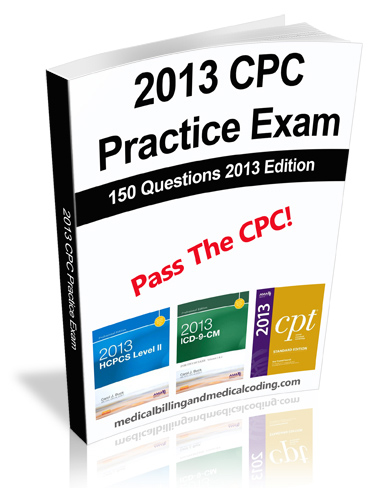




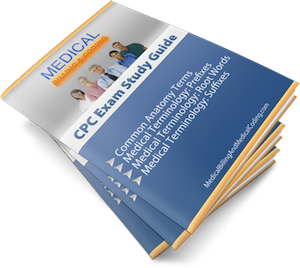 A
good practice exam should fully prepare its examinee for the real
exam. Knowing what to expect and not being surprised on exam day are
important.
A
good practice exam should fully prepare its examinee for the real
exam. Knowing what to expect and not being surprised on exam day are
important.
 Our
150 question CPC practice exam was created using the structure listed
above in order to emulate the actual CPC exam as closely as possible.
We felt that by doing this examinees would know exactly what to
expect on examination day. By utilizing this structure examinees
can better prepare for the exam by focusing on category specific
questions and identifying areas of weakness. Knowing what to expect
in detail also tend to help calm pre-test anxiety.
Our
150 question CPC practice exam was created using the structure listed
above in order to emulate the actual CPC exam as closely as possible.
We felt that by doing this examinees would know exactly what to
expect on examination day. By utilizing this structure examinees
can better prepare for the exam by focusing on category specific
questions and identifying areas of weakness. Knowing what to expect
in detail also tend to help calm pre-test anxiety.

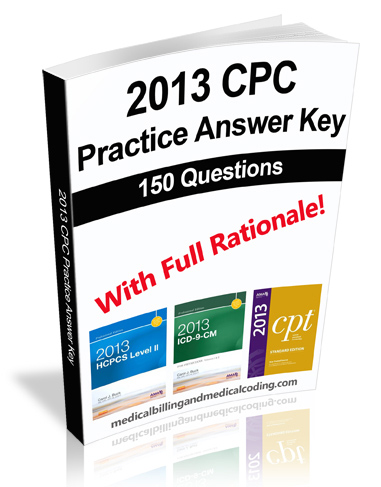
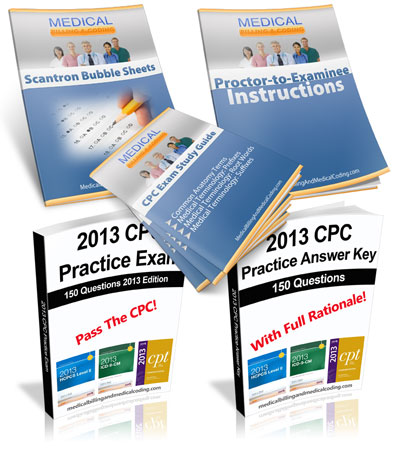


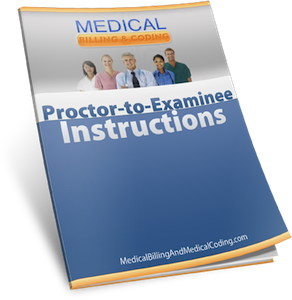



没有评论:
发表评论